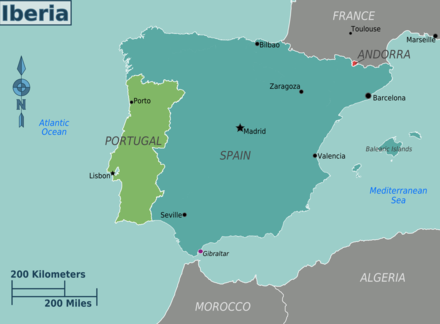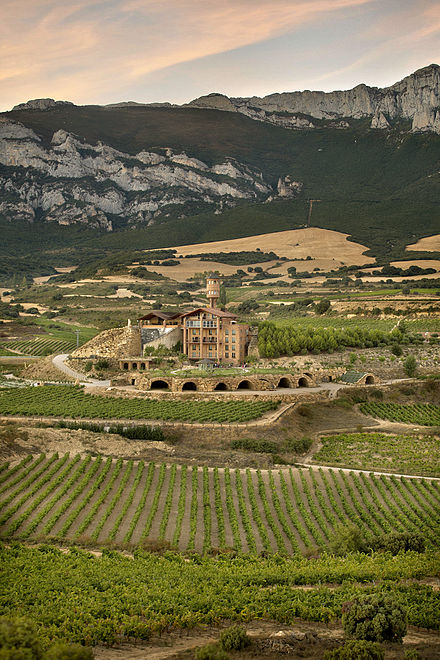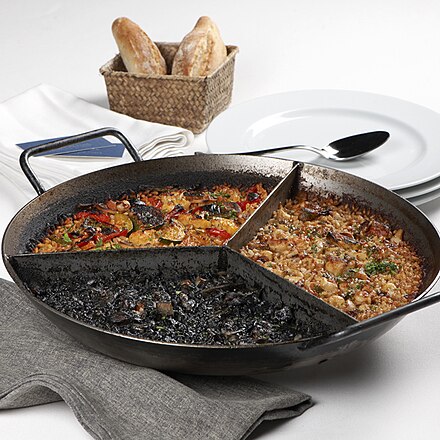Iberia - peninsula located in the extreme southwest of Europe
The Iberian Peninsula is the westernmost section of the European continent, lying between the Mediterranean Sea and the Atlantic Ocean. It is separated from France by the snow capped Pyrenees mountains.
While the Spanish Canary Islands and Portuguese islands Madeira and Azores are far from the Iberian mainland, they are integrated provinces in their respective countries, and described here as part of Iberia.
Countries

A tiny landlocked country in the Pyrenees mountains nestled between Spain and France, popular for skiing in the winter, hiking in the summer, and shopping year-round.
Portugal (including the Azores and Madeira)
This stunning country is bordered by Spain and the picturesque Atlantic Ocean.
Spain (including the Canary Islands and Spanish North Africa)
This country is one of Europe's best loved destinations for holidays and living: the culture, nightlife, beaches and history all give human beauty to a country that has so much natural beauty.
Overseas territory
The United Kingdom's stronghold on the Spanish coast since before the days of Napoleon.
Cities
- Barcelona — Gaudi's home and the capital of Catalonia.
- Bilbao — On Spain's northern coast, this is one part of Spain which has 4 definite seasons.
- Braga — In northern Portugal.
.jpg/440px-Pra%C3%A7a_do_Marqu%C3%AAs_de_Pombal_(Lisboa).jpg)
- Lisbon — Portugal's capital and most beautiful city. It's in a natural harbour, and makes a great city break.
- Madrid — Spain's imperial capital in the centre of the Spanish mainland. Madrid has plenty to offer the common visitor for however long they have to spend.
- Porto — On Portugal's northern coast, it was from here that explorers left to explore Africa and India.
- Seville — One of Spain's most southerly cities, Seville is the home of explorers who found the Americas.
- Valencia — Culturally amazing, Valencia is dynamic and changing, with beautiful beaches.
- Zaragoza — This is the capital of Spain's region of Aragon.
Other destinations

- Algarve — long beaches at the southwestern edge of Europe
- Azores — out in the Atlantic half-way to North America, these beautiful volcanic islands have a lovely climate year-round
- Gran Canaria — the most populated one of the Canary Islands is also the most diverse of them — verdant forests and sunwashed deserts can both be found on this island
- Ibiza — the partying capital of not only Europe but also the whole world, this small Mediterranean island also has historic towns and pine woods packed on it
- La Rioja — wine region in northern Spain, home to sleepy and scenic old towns
- Madeira — off the African coast, Madeira is also known as the "island of the eternal spring", and "the floating garden of the Atlantic"—and there is hardly any hyperbole in this
- Mallorca — too many tourists may be flocking to the beaches of this Balearic island for a sunbath, but step inland, and you'll have impressive mountain vistas all to yourself
- Tenerife — deserts seemingly straight out of the Moon, mountains, volcanoes, spectacular beaches, and a lively nightlife are all abound on this island, which was once the last familiar piece of land for the explorers of the New World
Understand
History
Separated from France by the Pyrenees mountains, its history has frequently taken a different path from the rest of Europe, giving the region a separate identity. The Basque people settled here millennia ago, retaining their culture to this day. The Roman Empire expanded into it in the 3rd century BCE, before being supplanted by the Visigoths in the 5th century. The peninsula again took on a non-European character when the Islam Berber and Arabic Moors took over in the 8th century, ruling parts of it until the 15th century. As Christian rule gradually took back the peninsula from the Moors, its people then looked outward; Portugal sponsored the Cape Route expeditions, and Spain the voyages of Columbus and Magellan-Elcano circumnavigation. The Tordesillas treaty divided the new lands between Spain and Portugal, allowing the Portuguese to colonise Africa, India and Brazil, while the Spanish Empire came to control much of the Americas and the Philippines. The Iberian Union between 1580 and 1640 held the Iberian peninsula, as well as the overseas colonies of both countries, at its time the world's largest empire.
Gold and silver from the colonies brought wealth and glory to the mother countries, but it was not sustainable. From the War of the Spanish Succession in the early 18th century, Spain and Portugal lost their status as great powers, and lost most of their colonies during the 19th century. While Brazil remained governed by a branch line of the erstwhile Portuguese royal house in the late 19th century, Spain lost Gibraltar to England in the 18th century, continental Latin America in the early 19th century and almost all its remaining colonies in the Spanish American War of 1898 which caused a literary movement often called "the generation of 98" to bemoan Spain's fall from glory.
Dictatorial and fascist governments kept Spain and Portugal out of World War II, although Spain in particular was devastated by its civil war in the late 1930s, while Portugal provided limited assistance to the British under the auspices of the longstanding Treaty of Windsor. Since the end of the Salazar and Franco regimes in the 1970s, both have become full members of the European Union. Since the mid-20th century, tourism has been a substantial part of the countries' economies, especially on the islands, and while many seaside resorts are dominated by tourists, much of the inland is still off the beaten path. While both countries became democratic in the late 20th century and enjoyed tremendous economic growth, they were hit hard by the 2008 Global Financial Crisis. Several regions of Spain, especially Catalonia, call for independence, or increased autonomy. In the Basque country, pro-independence violence (and some measure of anti-independence reprisals) have plagued the region since the late Franco era, but the situation has notably calmed down in the 21st century with a peaceful autonomy/independence movement increasingly distancing itself from any violence.
Gibraltar is a tiny British outpost dominated by a massive rock. It was ceded by Spain in 1713. Spain continues to seek its return.
Talk

- Spanish — Official language of Spain, with status of co-officiality in some regions with historic languages
- Portuguese — The official language of Portugal
- Basque — Co-official language in some regions of Spain, unrelated to any other living language, spoken in the Basque Country and Navarre in the northern part of the peninsula.
- Catalan — Co-official in several regions of Spain and the only official language in Andorra, mainly spoken in Andorra, the Balearic Islands, Catalonia and as Valencian in Valencia.
- Galician — Co-official language in Galicia, Spain, mainly spoken in Galicia and a small part of Asturias and Leon province. It is closely related to Portuguese
- Astur-Leonese — Not official, but spoken in several provinces of Spain: Asturias and part of the provinces of Leon, Salamanca and Zamora.
- Aragonese — Not official, but spoken in several valleys in the north of Aragon, Spain.
- Mirandese — Co-official in the Portuguese city of Miranda do Douro, Mogadouro and Vimioso. Part of the Astur-Leonese languages.
- English — Official language of Gibraltar
With the exception of Basque (and English), all the languages of the Iberian peninsula are from the Romance family of languages which has its roots in Latin, so if you speak one of those languages, you'll find it fairly easy to pick up the rest.
While most younger people have learnt English in school, it is not widely spoken or understood outside the small British exclave of Gibraltar, where it is the official language. As elsewhere in the world, English proficiency improves the closer you get to major tourists centres, especially in the resort cities along the Mediterranean coast and in Barcelona. As a general rule, English proficiency is higher in Portugal than in Spain.
Get in
The entire peninsula is in the Schengen Area, as are Spain and Portugal's overseas territories in the Atlantic Ocean and Africa.
By plane
 The Iberian peninsula is Europe's main hub for flights from South and Central America. Madrid's Barajas airport is the most important of the hubs, while Lisbon Airport is the main gateway from Brazil due to historic ties between the two countries. Both also have worldwide links. The situation is much the same with the two flag carriers: Spain's Iberia has an impressive South/Central America network, and Portugal's TAP flies from numerous destinations in Brazil and from African cities with colonial ties to Portugal. Both also codeshare with local airlines making an impressive number of links available throughout their focus areas.
The Iberian peninsula is Europe's main hub for flights from South and Central America. Madrid's Barajas airport is the most important of the hubs, while Lisbon Airport is the main gateway from Brazil due to historic ties between the two countries. Both also have worldwide links. The situation is much the same with the two flag carriers: Spain's Iberia has an impressive South/Central America network, and Portugal's TAP flies from numerous destinations in Brazil and from African cities with colonial ties to Portugal. Both also codeshare with local airlines making an impressive number of links available throughout their focus areas.
Outside the two main capitals, Barcelona El Prat is a major airport with flights from all over Europe (being the hub for continental low-cost airline Vueling), and select cities in Asia and North America. Important smaller airports in continental Spain and Portugal include Alicante, Faro, Malaga, and Porto. The countries' various islands and archipelagos all have their own airports, most of which are very well-served from Europe, though some smaller islands only receive domestic flights. Gibraltar has its own international airport, while mountainous Andorra relies on its road links to Barcelona and Toulouse (France).
By train
The conventional rail network has a different gauge (the distance between two rails) from that in most of Europe, so running cross-border trains has been difficult. The Spanish high speed rail network operates on the same standards as the French one, so through trains can be run from the French city of Perpignan to Barcelona and from either endpoint to the French or Spanish high speed rail network. RENFE and SNCF together run two daily direct trains from Paris to Barcelona and one train from Madrid to several destinations in the south of France. Since the route via Canfranc has been shut down, there is only one further rail connection between France and Spain, namely the one via Hendaye. Other connections through the Pyrenees have also been proposed, but seem unlikely. Nonetheless, conventional trains do ply the Hendaye route and the Spanish Talgo train was among the first practicable systems to handle breaks of gauge and is still highly regarded. The sleeper trains of yore (often called Trenhotel) have been cut down a lot since the turn of the millennium.
By boat
Get around
By plane
Given the distances involved, there are some routes on which flying makes sense. Service on once popular routes like Madrid - Barcelona has been reduced since the opening of new high-speed rail lines.
By train
Quality and speed of train service varies a lot. While high-speed lines between major cities are fast and convenient, there are some Iberian gauge legacy lines that take torturously long and make several detours making buses the faster option. In Portugal the fastest trains are tilting trains on upgraded legacy lines that are not as fast as Spanish high-speed rail but still often faster than driving. Plans to link Spain and Portugal by standard-gauge high-speed rail lines have not borne fruit.
By car
By bus
See
Beside the natural scenery, Iberia has a cultural heritage back to the Stone Age. As the peninsula was spared from the World Wars, many archaeological sites and old towns remain in good condition.
Spain has several of the world's most renowned art museums, including the Prado and Reina Sofia in Madrid, and Guggenheim in Bilbao.
Do
Eat
 See also: Spanish cuisine
See also: Spanish cuisine
Having long coastlines, Spain and Portugal are known for their seafood dishes. In Portugal, cod fish (bacalhau) is among the most appreciated dishes. Spain is also known for jamón ibérico, literally "Iberian ham." Spain – especially Valencia and Catalunya – are the wellspring of tapas, small plates to be eaten with wine. In addition, Spain has been at the forefront of new directions in international super-high-end cooking.
Drink
Sangria is wine usually mixed with a collaboration of fruits and some added spices like cinnamon.
However, although sangria is popular with tourists it is rare to see Spanish people drinking it. The locals drink tinto de verano - red wine diluted with lemonade or carbonated water. Spain is also known for Rioja and Jerez (Sherry).
Portugal is known for its Port wines, among others.
Stay safe
Go next
- France — across the Pyrenees to the north and east, France is among the most visited countries in the world and rightfully so: its cities, its cuisine and its natural beauties — be they sunny beaches or alpine peaks like Montblanc — have fascinated and attracted generations of visitors
- Morocco — just a short hop across the strait of Gibraltar is this North African beauty that blends Arab, African and European influences into its own captivating culture
- Caribbean — if you are sailing around the world, your landfall in the western hemisphere will likely be somewhere in the Caribbean. If your mode of travel is plane instead, Spain's flag carrier will get you almost any place Caribbean or Central America